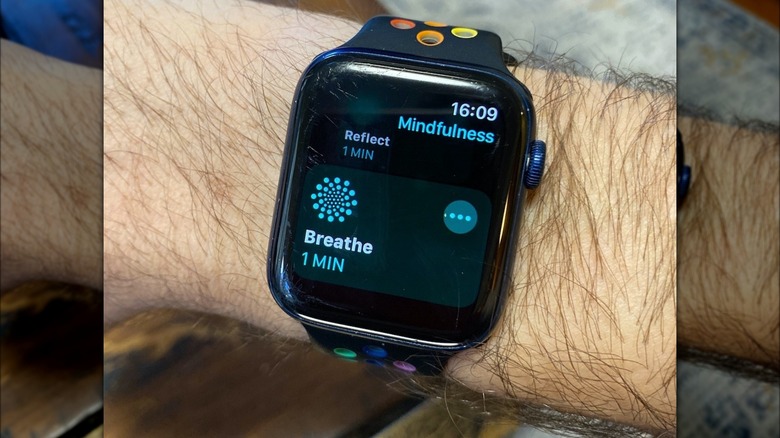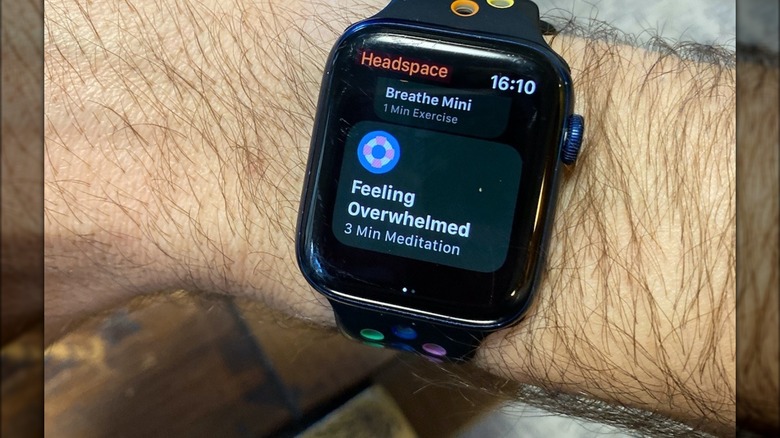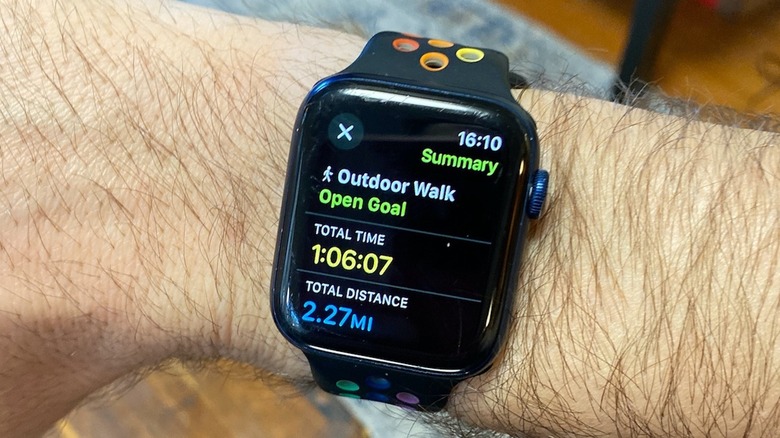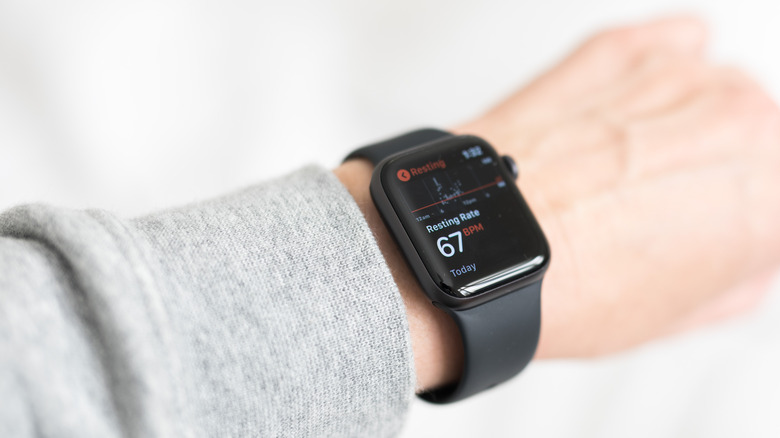3 Apple Watch Apps To Help Manage Stress
Modern life can be very stressful for many of us, and sometimes that stress may seem impossible to overcome or even manage. Fortunately, there are many ways to help mitigate that stress, including using modern tech that wasn't available even just a few years ago. That includes the Apple Watch. Since its debut nearly a decade ago, Apple has touted it as a great health and fitness device (among many other uses). Since mental health can be impacted by physical health, the wearable device can help you cope with stress in several different ways, especially as more and more apps are developed for the product.
The Apple Watch has multiple sensors built into it that measure your sleep, heart rate, time spent in daylight, and other important physical metrics that can help estimate stress levels. Paired with its ability to easily and regularly send you reminders and notifications, the Apple Watch can also help you start and maintain habits to help reduce stress — as well as help you deal with it directly during a particularly acute bout. Here are three Apple Watch apps to help manage stress that I've thoroughly tested (more on this process can be found at the end of the list).
Mindfulness
You may know the Mindfulness app better as Breathe, which was its name before it changed alongside the introduction of additional new features. Previously, the Breathe app provided a guided breathing session that could last as little as one minute. The Apple Watch would periodically suggest you stop what you're doing and literally take a breath — using visuals and vibrations to guide the intake and exhale of your breathing, helping calm your body and mind.
That function remains, though it's been joined by the Reflect feature — a slightly more complex guided meditation. Similar to Breathe, Reflect will notify you with a prompt or question to focus on for a minute of mindfulness training. The app also includes mood tracking with a State of Mind mode, where you can choose from a range of emotions and log how you're feeling at the moment (or your general mood of the day). Similar to many exercise apps, Mindfulness gamifies and tracks your progress to help you recognize patterns in your life that are helping or worsening your mood so that you can take educated steps toward improving it in general.
As an added bonus, there are three Breathe-inspired faces (Classic, Calm, and Focus) available for your Apple Watch, so you can put stress management front and center. One drawback is that the app's persistent notifications can come at inopportune times, making it one of the settings on your Apple Watch that can ruin your experience. If you find yourself tempted to turn the notifications off, try to make an effort to instead adhere to them and stop — even for just a minute — to take a breath.
Headspace
There is a wealth of evidence that meditating and practicing mindfulness can help you manage and reduce your stress. While the native Mindfulness/Breathe app on the Apple Watch is great for constantly reminding you to take a moment for self-reflection, that app only provides very basic guided meditations. Headspace, on the other hand, is the exact opposite — with a wide range of very specific and step-by-step guided meditations for both dedicated practitioners and beginners who've never meditated once in their lives. It's a popular and well-designed smartphone app, and its smartwatch companion is one of the best Apple Watch apps available.
There's a lot of production value in Headspace's guided meditations and mindfulness training sessions, which include visually appealing animations. The app also offers advanced features, including live group meditations and sleep assists like soothing stories, sounds, and music. Elsewhere, it can provide reminders to meditate as well as give you handy playback controls to easily pause and rewind sessions from your wrist. It can also play shorter guided meditations directly from the device so you don't have to rely on your iPhone, and it logs and gamifies your progress by tracking your streaks and incentivizing you to keep practicing mindfulness.
One downside is that many of Headspace's features are paywalled behind the premium version of the app, which costs $12.99 per month or $69.99 per year, with a free trial period available.
Workout
Physical exercise is one of the best ways to combat stress and anxiety, and the Apple Watch a great device to help you strengthen yourself physically. There is no shortage of workout platforms for the Apple Watch, but one of the best is the Workout app that's built right into the peripheral. With a tap of the finger, you can choose from the many different physical activities the app is programmed to track using your heart rate, location, and other metrics. This is extremely useful for not only measuring your progress during a workout (like keeping tabs on burned calories or how many laps you've swam) but also tracking and gamifying your long-term progress. The end goal is to form a positive habit of physical activity.
The Apple Watch will also notify you if you've been less active on a particular day, pushing you to go out and get in a quick jog if you need to, for example. Not only is this great for your physical health, but sometimes a short run around the block will do wonders for your state of mind and help clear short-term stress — as well as help make long-term stress more manageable.
One very useful Workout feature is a prompt it sends you if you're in the middle of an activity — such as walking, running, or swimming — and you've forgotten to start tracking it on the app. It can then retroactively track the activity from when it thinks you started it (based on your metrics) and is surprisingly accurate at doing so. Unfortunately, to get the most out of the app, you'll need to subscribe to Fitness+, which costs extra (though it can be bundled with other Apple services). Regardless, the free version still has plenty to offer.
How these apps were selected
I've owned an Apple Watch for eight years and have long come to see it not as a flashy gimmick but as an incredibly helpful peripheral to use throughout the day, every day. I've personally used all three apps on this list for years and know the ins and outs of each. That includes using many of the guided meditations offered by both the free and paid versions of the Headspace app, as well as the simpler Reflect and Breathe guided meditations that come with the Apple Watch's native Mindfulness app. I've used the Workout app for the longest and have spent more time with it than any other app on the. I've tested many of the different activities included with it, as well as its manual input option. (I'm still patiently awaiting the day Apple finally adds rucking as a default workout, though.)
None of these apps should be used alone as your only strategy to combat stress, but rather as supplements to broader lifestyle habits and choices that can help mitigate it. Used properly, they're tools to get through your day a little (or a lot) easier. They can't completely eliminate the stress of daily life, but they can certainly help to manage it.




